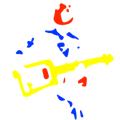People seem to place a lot of importance on scales, they tend to either fascinate or offend beginner players as if somehow they are either the solution to all of your problems or the root of all evil. Well they're neither, they're just scales.
I go into more detail in the theory section but for now I'll just introduce the basics and lay a few out in some standard cbg tunings
Naming Scales
The way we name scales can be helpful when getting started. We use both a letter and a word to describe the scale, C major, A minor, E blues etc. The letter tells us which note to start and end the scale on, also known as the key centre, while the descriptor tells us which notes within that range to use. Let's start with keys.
Keys
If you're tuned GDG then both your top and bottom strings are a G note. They sound different because one is lower than the other but if you play them together they work. Their wavelengths have a strong mathematical relationship and we give them the same name. The distance between them we call an octave.
Likewise other notes can be seperated by an octave. The A note on fret 2 on the bottom string is an octave away from A on fret 2 on the top string, or fret 7 on the middle string and fret 14 on the same string. If the numbers and letters are confusing grab your guitar and play them, it'll start making a lot more sense.
When this note either end of the octave is the start and end point of your scale then you are said to be in the key of that note. Start and end on G and you're in the key of G, start and end on A and you're in A etc.
Types of scales
In western music we have 12 different notes available to us, hence there are 12 frets between the open string and the octave. Most songs won't use all 12 though, they'll limit themselves to a specific set of notes which we call a scale. This choice of notes, or scale, gives the music a particular flavour. A major scale has a certain sound that works in Gospel music for example, while a minor scale or a blues scale works on the blues.
This specific subset of the 12 available notes creates a particular pattern that translates to a series of shapes on your guitar. Move those patterns up and down and the scale maintains its flavour, it is still major, minor etc. but changes to different keys as you start and end on different notes. So once you've learned a G major scale you just move the whole thing up 2 frets and you've got an A major scale, two more to B etc. Check the theory pages to learn more about how this works.
Scale positions
The following pdf's contain scale positions in one octave for major, major pentatonic, minor pentatonic and blues scales. They are notated in TAB and standard notation. Use these documents as a reference when you need them, don't try to learn them all at once.
